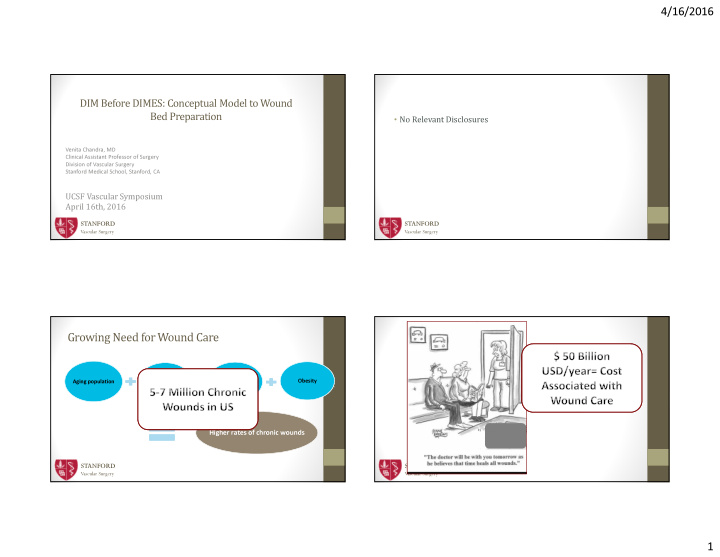



4/16/2016 DIM Before DIMES: Conceptual Model to Wound Bed Preparation • No Relevant Disclosures Venita Chandra, MD Clinical Assistant Professor of Surgery Division of Vascular Surgery Stanford Medical School, Stanford, CA UCSF Vascular Symposium April 16th, 2016 STANFORD STANFORD Vascular Surgery Vascular Surgery Growing Need for Wound Care Higher rates of Obesity Aging population Chronic disease diabetes 3 Higher rates of chronic wounds STANFORD STANFORD Vascular Surgery Vascular Surgery 1
4/16/2016 Chronic Wound The vicious circle of delayed wound healing Degradation of ECM and growth factors • Stuck in the Inflammatory Phase Delayed Bacterial proteases • Defective remodeling of Wound and toxins ECM Healing • Fail to re-epithelialize Cells produce excess proteases Increased inflammatory response Falanga V. The Chronic Wound: Impaired Healing and Solutions in the Context of Wound Bed Preparation. Blood Cells and Diseases, STANFORD STANFORD 2004;32:88-94. Vascular Surgery Vascular Surgery Gibson D, Cullen B, Legersterr E, Harding KG, Schultz G. MMPs Made Easy. Wounds International 2009; 5 How do we get a chronic wound to heal? Wound Bed Preparation Convert the chronic wound into an acute wound and allow normal • Preparing the body to do its own healing healing to take place • Hippocrates • “vis medicatrix naturae” • Natural forces within us are the true healers of disease STANFORD STANFORD Vascular Surgery Vascular Surgery 2
4/16/2016 Wound Bed Preparation Paradigm • Devitalized Tissue • Barrier to cell migration • Provides ideal environment for bacterial proliferation • Prolongs the inflammatory response (Biological Agents, Growth Factors, (Biological Agents, Growth Factors, Skin Substitutes, Adjunctive Skin Substitutes, Adjunctive Therapies) Therapies) STANFORD STANFORD Sibbald RG et al. Ostomy/Wound Management 2000;46(11):14-35. Vascular Surgery Vascular Surgery Falanga V. Wound Repair Regen. 2000;8:347-352. • Devitalized Tissue • Barrier to cell migration • Provides ideal environment for bacterial proliferation • Prolongs the inflammatory response STANFORD STANFORD Vascular Surgery Vascular Surgery 3
4/16/2016 • All chronic wounds sit somewhere along a bacterial spectrum More frequent debridement = More frequent debridement = STANFORD STANFORD faster healing faster healing Vascular Surgery Wilcox et. al. JAMA Derm. 2013 Vascular Surgery • Biofilm • Shed bacteria • Excessive Fluid • Bacteria protected by • Suppress host immune • Exudate contain proteases, exopolysaccharide shield response inactivate growth factors • Highly inflammatory • Dessication • Slows epithelial cell migration • Not too moist, not too dry…..Just right STANFORD STANFORD Vascular Surgery Vascular Surgery 4
4/16/2016 Cliff Like Edge • If wound edge not migrating after appropriate wound bed preparation, then healing is vs. stalled • First re-assess the patient • Consider advanced therapies: • Skin substitutes, Skin Grafting, NPWT, HBOT STANFORD STANFORD Vascular Surgery Vascular Surgery Conclusions • Concept of wound preparation focused on re-balancing the chronic wound environment to stimulate and allow the natural healing process to continue Thank You! • Wound Preparation: vascular.stanford.edu • Debridement • Bacterial balance/infection control • Moisture Management • Edge effect STANFORD STANFORD Vascular Surgery Vascular Surgery 5
Recommend
More recommend